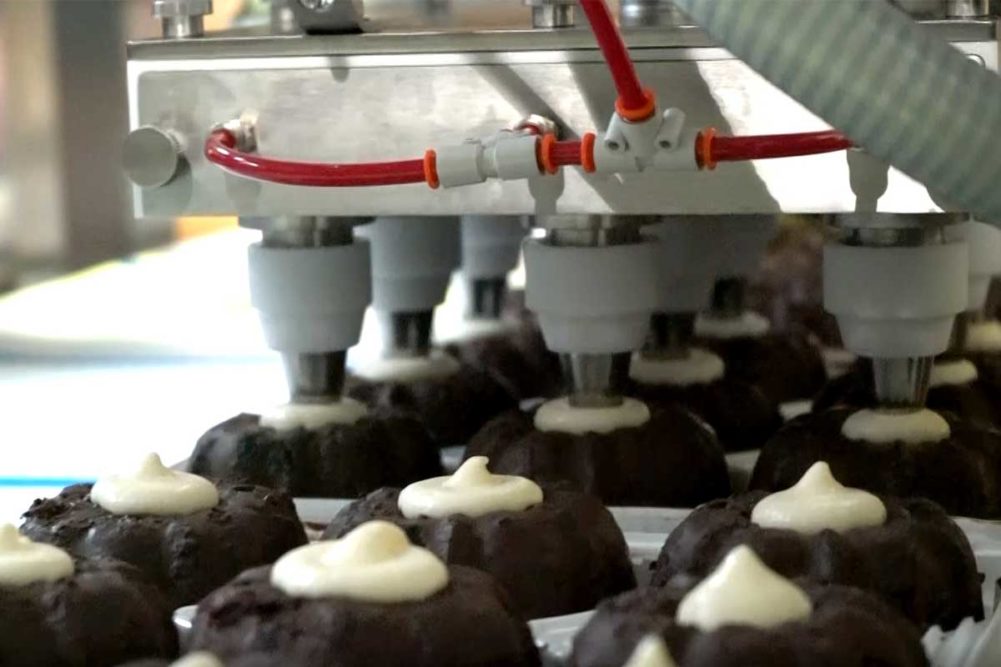Sanitation and accuracy are key issues when applying a nice sheen on buns and pastries during the glazing process. Often egg wash is used, but many bakeries have turned to non-egg alternatives to provide that shine on brioche.
However, several of these alternatives require careful cleaning processes and mist control to prevent nearby equipment from getting a sticky surface.
At the recent IBIE 2022 trade show, Burford Corp. offered its third generation of its spray applicator featuring a new modular flush-in-place (FIP) system, tanks for storing gray water and a Dosatron that injects chemicals and provides automatically timed turbulent flow to help extend the life in between deep cleaning.
“We have options like mist collection — a vacuum system with filters that sits off to the side and connects to the downstream hood and collects the atomized airborne particulates that can get on surfaces around the system,” Mr. Miller said. “It’s pretty standard for most bakeries because anytime you’re atomizing and spraying through a nozzle, you’re going to have airborne mist.
“Additionally, our vision system allows us to spot spray so there’s less mist, less product waste and less quality concerns that are a result of spraying empty pockets,” he added. “We’re using cone sprays that are targeted and not spraying when product isn’t present.”
GOE/Amherst Stainless Fabrication introduced the next generation Variable Profile Liquid Spray (VPLS) system at the recent Baking Expo. The VPLS sprayer provides greater accuracy, reliability and ease of sanitation.
“GOE is using flow meters in critical applications to monitor, alarm and control the application rate on products,” said Norm Searle, sales and marketing, GOE/Amherst Stainless Fabrication. “These devices allow us to maintain exact delivery rates and compensate for changes in temperature and viscosity.”
Mr. Searle said a primary objective is to accurately deliver the spray with cross-the-band consistency to ensure acceptable finishing, reduce ingredient consumption and ensure the glazing meets labeling requirements on the package.
“In a perfect world, delivery of each ingredient would be exact,” he said. “In reality, various factors limit absolute accuracy. As technology advances, opportunities become available to improve accuracy either from material advances, electrical/electronic/software developments — or both.”
Bob Peck, vice president of engineering, E.T. Oakes, pointed out that PLCs combined with servo motors have increased accuracy, repeatability and reliability over chain-driven systems that require lubrication and maintenance.
“Variable-frequency drive motors or air-cylinders do not produce highly repeatable deposits because of the fluctuation of their operation and air pressure,” he explained. “Servo motors provide closed-loop feedback. That means if we instruct it from a PLC to provide 1,000 pulses on this motor, we receive feedback that it actually provided 1,000 pulses. That’s where the accuracy comes in.”
Mr. Peck said PLC systems can include diagnostic screens to troubleshoot problem areas and test sensors, encoders and other key components. Maintenance logs can be included within the PLC program to schedule maintenance and track machine-running hours for routine maintenance requirements. Moreover, servos provide faster speeds.
“In the case of cake depositing, we increased the number of rows a minute,” Mr. Peck said. “We used to do around 60, and now we’re doing around 100 a minute.”
For decorating, Apex Motion Control uses vision and motion controls with its cobots. For example, the end effector on a robotic arm that’s holding the decorating tip can freely move in any direction.
“It is not static like a standard icing nozzle you would typically see on an icing depositor,” said Jamie Bobyk, marketing manager, Apex Motion Control. “No two cakes are generally the same after baking. The tops of the baked cakes tend to have peaks and valleys and even the cakes are not perfectly round. The vision system follows the cake or cookie as it moves down the conveyor line and senses exactly where the deposit of icing needs to be.”
This article is an excerpt from the November 2022 issue of Baking & Snack. To read the entire feature on Finishing/Icing/Topping, click here.





